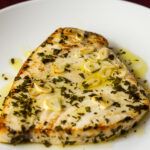When I was ordering the pork belly from Niman Ranch for my first attempt at home cured bacon, I had room to add more items to my order without increasing my shipping charges. So to maximize the shipping costs I ordered some guanciale, which is kind of like pancetta or bacon, but it is cured pork jowl rather than belly.
Guanciale is the traditional ingredient used in the classic Roman Pasta dishes, Bucatini all’Amatricianna and Spaghetti alla Carbonara. Since guanciale is not easy to find outside of Rome and the Lazio region in Italy, and until recently impossible here in the U.S., substituting pancetta for the guanciale has become commonplace.
Two things struck me when I received the guanciale. First, it was liberally seasoned on top with herbs including rosemary. I am no expert on the subject but I get the feeling that this was an American’s idea and this is not done in Italy. Since I was going to be using it in pasta sauce I was not thrilled with this because I just don’t think rosemary has any place in a sauce. The other thing I noticed as soon as I sliced it is that it has much more fat than pancetta.
I have made two Roman pasta dishes with my guanciale, rubbing off as much of the seasoning on top as I could first. I substituted it for the pancetta in my father’s Bucatini all’Amatriciana recipe. There is a subtle difference from the pancetta version in the resulting dish, with a more pronounced pork flavor and richer feel to it from the additional fat rendered into the sauce. I really liked it, but I am not going to be taking a staunch purist stance that amatriciana can only be made with guanciale, there is not that much of a difference and it is excellent both ways.
The other dish I tried is Spaghetti alla Gricia, which is made with guanciale, hot pepper and Pecorino Romano cheese. It is sometimes referred to as amatriciana in bianco, which means white amatriciana, because it is made without tomatoes. I make a lot of pasta sauces with tomatoes, so it is nice when I can find tomato-less pasta that I like to break up the monotony. Now this I definitely would not make without guanciale, it is the centerpiece here, and it would not be the same with a substitution like pancetta.









12 Responses
Quel pezzo di grasso è lardo da Toscana (Lucca)??? mi piace molto! 😀
I make and dry aged my guanciale. Now I have to cook it. Any ideas for getting the skin off easily? I’ll keep the skin to make sauces with.
Question is, can I treat this just like regular bacon?
You are very ambitious if you cured your own guanciale. It is very difficult to find a really good guanciale in the USA, but Tempesta in Chicago makes a fairly decent product. The answer is that you can treat it just like bacon. In fact, in hotels in Italy that cater to American tourists, they have it on their menu as “bacon”. When I commented to a waiter about this he acted quite surprised and said “Yes, this is guanciale, but Americans do not know what guanciale is.”
In the south it’s a staple meat. Wal mart and most grocers has it. We use for seasoning of beans and love it as it is on white bread .
It’s not even close to what cured Italian Guanciala is.
No rosemary in guanciale, not rosemary in sauce?
Lots of sauces have rosemary, as well as cloves, nutmeg, allspice, etc. my grandmother b. 1890, Giaole in Chianti, Tuscany(near Arezzo). So i am puzzled.
I wrote this a long time ago. Didn’t have much experience with guanciale. I use it all the time now and don’t rub any seasoning off and they all have rosemary. But I will say that first one had a hell of a lot of rosemary.
Also I meant pasta sauce. I don’t typically put rosemary in a pasta sauce or see it done too often. Naturally rosemary is at home in sauces for certain meats.
Where are you getting yours? I’m out of NY/NJ area living in SC – I need a good online source for guanciale and sopressata.
[email protected]
When frying guanciale, it seems to stay uncooked. Is this typical?
what
Maybe you should turn on your stove Margaret